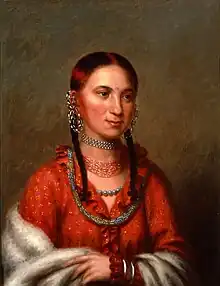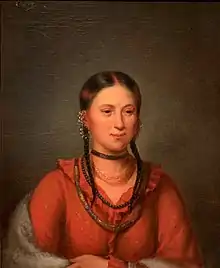Eagle of Delight
Hayne Hudjihini or Eagle of Delight (c. 1795 - 1822) was a prominent Otoe woman from what is now Nebraska.
Eagle of Delight | |
|---|---|
| Hayne Hudjihini | |
 Eagle of Delight (Hayne Hudjihini), painted by Charles Bird King, c. 1822 | |
| Otoe leader | |
| Personal details | |
| Born | c. 1795 |
| Died | 1822 Nebraska |
| Cause of death | Measles |
| Resting place | Nebraska |
| Spouse | Sų Manyi Kathi |
The daughter of a chief, Hayne Hudjihini belonged to the Eagle clan.[1] She became one of the five wives of Chief Sų Manyi Kathi, or Shaumonekusse (Otoe, ca. 1785–1837),[2], who belonged to the Bear clan.[1]
Travels
In 1822, Hayne Hudjihini accompanied her husband with an Indian delegation of chiefs to Washington D.C., where they met James Monroe, the President of the United States. She was described by those who met her as beautiful and charming. The Bureau of Indian Affairs (BIA) commissioned Charles Bird King to paint portraits of Hudjihini and Shaumonekusse.
Death
Shortly after her visit, Hayne Hudjihini died of measles,[1] probably contracted during her travels.[3][4]
Portrait

When Chief Mahaska of the Ioway tribe saw Eagle of Delight's portrait in winter 1836 and 1837 on a visit to Washington, DC, he was certain that she was his mother. However, at nearby King's gallery, a copy of Eagle of Delight's portrait hung next to the portrait of Rantchewaime (Female Flying Pigeon), his mother, whom he recognized by her fan. It turned out that Mahaska was mistaken because his mother, who had died when he was four, had been a neighbor and close friend of Eagle of Delight. The two women had often dressed in similar colors and braided their hair the same way. The copy of Eagle of Delight's portrait had added the blue forehead spot, the mark of royalty, which helped him tell the two women apart. Arrangements were made to send copies of the paintings to Chief Mahaska and to Shaumonekusse, who were pleased to have a painting of their mother and wife respectively.[5]
Although the original portrait of Eagle of Delight was destroyed in a fire at the Smithsonian Institution in 1865, a patron donated King's personal copy to the White House in 1962. The portrait now hangs in the White House Library.[6] There is a portrait of the same subject by Henry Inman on view at The Met Fifth Avenue in Gallery 756. This rare portrayal of a Native American woman, Hayne Hudjihini, Eagle of Delight—wife of Sumonyeacathee, Chief of the Otoe-Missouria people—emphasizes her distinctive beauty and bearing. She is adorned with earrings, necklaces, and a silver bracelet.[7]
References
- Pipestem, Veronia, Rock, and Wolf. "Native Perspectives". The Metropolitan Museum of Art. Retrieved 15 January 2021.
{{cite web}}: CS1 maint: multiple names: authors list (link) - "Shaumonekusse", Indian Tribes of North America, Washington, DC: Smithsonian Institution, 1910, accessed 12 Apr 2020
- "Old map by McKenney - Hayne-Hudjihini the Eagle of Delight". Antique Map Price and high resolution image source. Retrieved 2013-01-31.
- McKenney, Thomas L (1872). History of the Indian tribes of North America with biographical sketches and anecdotes of the principal chiefs. Embellished with one hundred portraits from the Indian Gallery in the War Department at Washington. Philadelphia: D. Rice & Co. Retrieved 2013-01-31.
- "Young Mahaskah, Ioway Chief". Access Genealogy. Archived from the original on 2013-02-15. Retrieved 2013-02-02.
- "Portraits of Native Americans in the Library". The White House, President George W. Bush Archives. Retrieved 2013-02-02.
- ""Hayne Hudjihini, Eagle of Delight"". Metropolitan Museum of Art. Retrieved 2020-01-25.